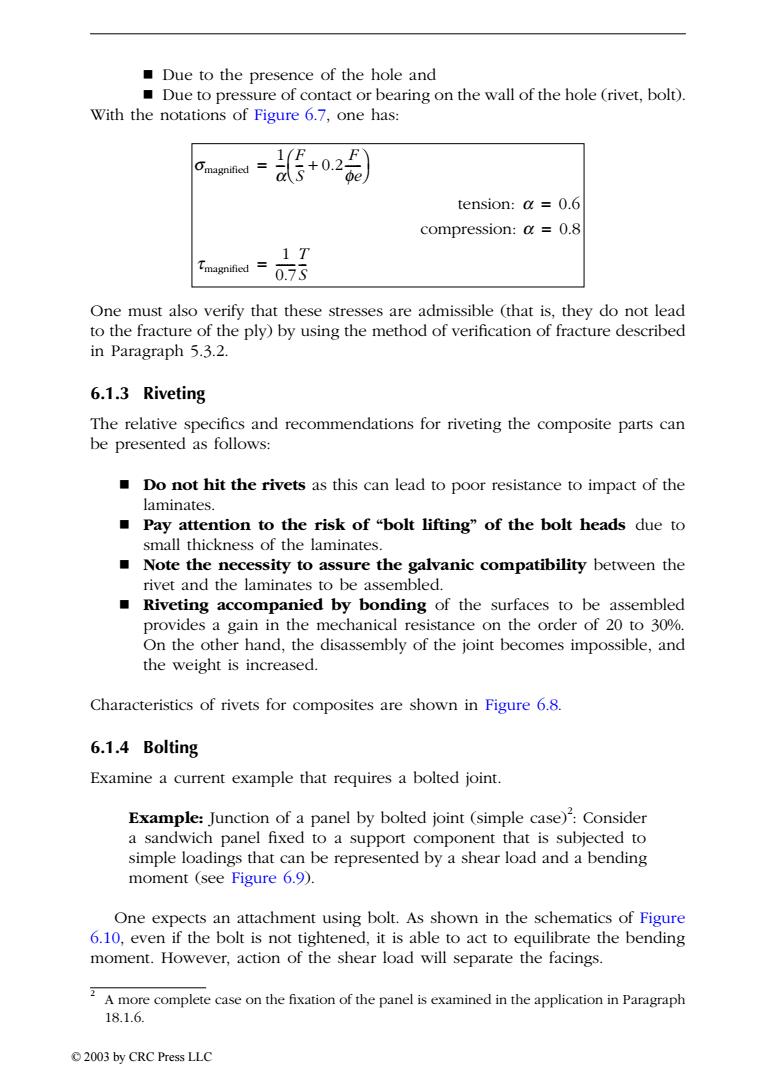正在加载图片...

Due to the presence of the hole and Due to pressure of contact or bearing on the wall of the hole (rivet,bolt). With the notations of Figure 6.7,one has: F 0.2 tension:a=0.6 compression:a 0.8 1T Tmagnified= 0.73 One must also verify that these stresses are admissible (that is,they do not lead to the fracture of the ply)by using the method of verification of fracture described in Paragraph 5.3.2. 6.1.3 Riveting The relative specifics and recommendations for riveting the composite parts can be presented as follows: Do not hit the rivets as this can lead to poor resistance to impact of the laminates. ■Pay attention to the risk of“bolt lifting”of the bolt heads due to small thickness of the laminates. Note the necessity to assure the galvanic compatibility between the rivet and the laminates to be assembled. Riveting accompanied by bonding of the surfaces to be assembled provides a gain in the mechanical resistance on the order of 20 to 30%. On the other hand,the disassembly of the joint becomes impossible,and the weight is increased. Characteristics of rivets for composites are shown in Figure 6.8. 6.1.4 Bolting Examine a current example that requires a bolted joint. Example:Junction of a panel by bolted joint(simple case):Consider a sandwich panel fixed to a support component that is subjected to simple loadings that can be represented by a shear load and a bending moment (see Figure 6.9). One expects an attachment using bolt.As shown in the schematics of Figure 6.10,even if the bolt is not tightened,it is able to act to equilibrate the bending moment.However,action of the shear load will separate the facings. A more complete caseon the fixation of the panel is examined in the application in Paragraph 18.1.6. 2003 by CRC Press LLC Due to the presence of the hole and Due to pressure of contact or bearing on the wall of the hole (rivet, bolt). With the notations of Figure 6.7, one has: One must also verify that these stresses are admissible (that is, they do not lead to the fracture of the ply) by using the method of verification of fracture described in Paragraph 5.3.2. 6.1.3 Riveting The relative specifics and recommendations for riveting the composite parts can be presented as follows: Do not hit the rivets as this can lead to poor resistance to impact of the laminates. Pay attention to the risk of “bolt lifting” of the bolt heads due to small thickness of the laminates. Note the necessity to assure the galvanic compatibility between the rivet and the laminates to be assembled. Riveting accompanied by bonding of the surfaces to be assembled provides a gain in the mechanical resistance on the order of 20 to 30%. On the other hand, the disassembly of the joint becomes impossible, and the weight is increased. Characteristics of rivets for composites are shown in Figure 6.8. 6.1.4 Bolting Examine a current example that requires a bolted joint. Example: Junction of a panel by bolted joint (simple case)2 : Consider a sandwich panel fixed to a support component that is subjected to simple loadings that can be represented by a shear load and a bending moment (see Figure 6.9). One expects an attachment using bolt. As shown in the schematics of Figure 6.10, even if the bolt is not tightened, it is able to act to equilibrate the bending moment. However, action of the shear load will separate the facings. 2 A more complete case on the fixation of the panel is examined in the application in Paragraph 18.1.6. smagnified 1 a --- F S -- 0.2 F fe + ----- Ë ¯ Ê ˆ = tension: a = 0.6 compression: a = 0.8 tmagnified 1 0.7 -------T S = -- © 2003 by CRC Press LLC